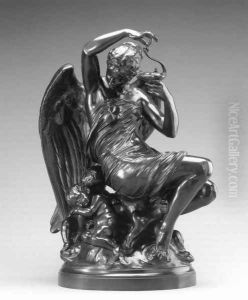Emile-Andre Boisseau Paintings
Émile-André Boisseau was a French sculptor whose career spanned the late 19th and early 20th centuries, a period that witnessed significant transformations in the world of art. Born in 1842 in Nevers, France, Boisseau was introduced to the arts at an early age, likely influenced by the rich cultural heritage of his homeland. He pursued his passion for sculpture, eventually moving to Paris, the epicenter of the art world during that era. There, he studied under renowned sculptors and educators, which honed his skills and artistic vision.
Boisseau's work is characterized by its classical style, attention to detail, and the emotional depth of its subjects. He was adept in both religious and secular themes, creating sculptures that ranged from public monuments to private commissions. His ability to capture the human form with both realism and idealism won him accolades and recognition from his peers and the public alike. Among his notable works are statues and reliefs that adorn various public spaces and institutions in France, reflecting the nation's appreciation for art and history.
Throughout his career, Boisseau participated in numerous exhibitions, including the prestigious Salon in Paris, where artists of the time aspired to present their work. His contributions to the art world were recognized with several awards and honors, cementing his reputation as a significant sculptor of his time. Despite the advent of modernism, Boisseau remained committed to the classical tradition, believing in the timeless beauty and significance of the human figure in art.
Émile-André Boisseau's legacy is not just in the sculptures he left behind but also in his influence on younger artists. He was a respected teacher, imparting his skills and philosophy to a new generation of sculptors. Boisseau died in 1923, but his work continues to be admired for its craftsmanship, beauty, and emotional resonance. His sculptures are a testament to the enduring appeal of classical art and serve as a bridge between the past and the present in the ever-evolving world of art.
